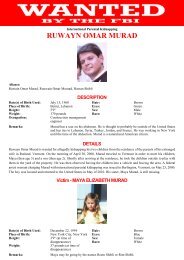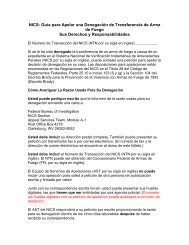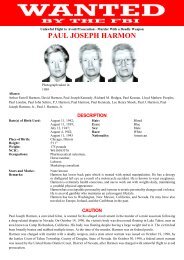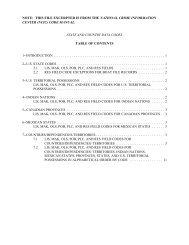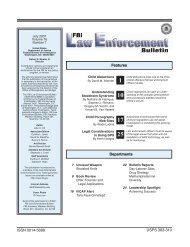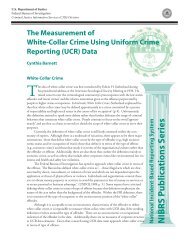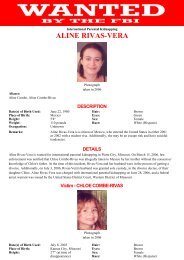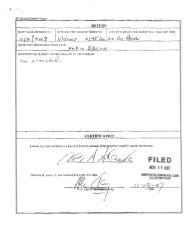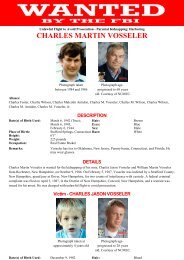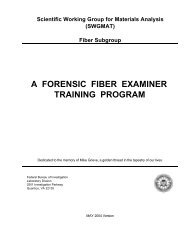F B I Law Enforcement Bulletin - June 2003 Issue
F B I Law Enforcement Bulletin - June 2003 Issue
F B I Law Enforcement Bulletin - June 2003 Issue
You also want an ePaper? Increase the reach of your titles
YUMPU automatically turns print PDFs into web optimized ePapers that Google loves.
20 / FBI <strong>Law</strong> <strong>Enforcement</strong> <strong>Bulletin</strong><br />
“ In interviewing<br />
and detecting<br />
deception,<br />
synchrony plays<br />
an important role.<br />
”<br />
Special Agent Navarro is assigned to the FBI’s Tampa office and also<br />
serves in the FBI’s National Security Division’s Behavioral Analysis Program.<br />
others have a good time and when<br />
they feel comfortable in their presence.<br />
Experiencing comfort in the<br />
presence of strangers becomes<br />
more difficult, especially in stressful<br />
situations, such as during an interview.<br />
A person’s level of comfort<br />
or discomfort is one of the most<br />
important clues interviewers should<br />
focus on when trying to establish<br />
veracity. Tension and distress most<br />
often manifest upon guilty people<br />
who must carry the knowledge of<br />
their crimes with them. Attempting<br />
to disguise their guilt places a distressing<br />
cognitive load on them as<br />
they struggle to fabricate answers to<br />
what otherwise would be simple<br />
questions. 4<br />
When comfortable, an individual’s<br />
nonverbal behavior tends to<br />
mirror the other person present. 5<br />
For example, if one person leans<br />
forward, the other tends to do so as<br />
well. Or, if one leans to the side<br />
with hands in pockets and feet<br />
crossed, the other person may do<br />
the same. Subconsciously, people<br />
demonstrate their comfort with<br />
whom they are talking. When<br />
touched, people may touch back to<br />
emphasize a point. Some may display<br />
their comfort more openly,<br />
such as showing more of their torso<br />
and the insides of their arms and<br />
legs. People who speak the truth<br />
more often display comfort because<br />
they have no stress to conceal nor<br />
do they have guilty knowledge to<br />
make them feel uncomfortable. 6<br />
While seated at a table, people<br />
comfortable with each other will<br />
move objects aside so that nothing<br />
blocks their view. Over time, they<br />
may draw closer so that they do not<br />
have to talk as loud, and their<br />
breathing rhythm, tone of speech,<br />
pitch, and general demeanor will<br />
become similar.<br />
Subtleties of comfort contrast<br />
with discomfort. People show discomfort<br />
when they do not like what<br />
is happening to them, what they are<br />
seeing or hearing, or when others<br />
compel them to talk about things<br />
that they would prefer to keep<br />
hidden. People first display discomfort<br />
physiologically—heart rates<br />
quicken, hairs stand up, perspiration<br />
increases, and breathing<br />
becomes faster. Beyond the physiological<br />
responses, which are autonomic<br />
and require very little thinking,<br />
people primarily manifest<br />
discomfort nonverbally instead<br />
of vocally. They tend to move<br />
their bodies by rearranging themselves,<br />
jiggling their feet, fidgeting,<br />
or drumming their fingers when<br />
scared, nervous, or significantly<br />
uncomfortable. 7<br />
If, while the interviewer remains<br />
relaxed and poised, the<br />
interviewee continually looks at the<br />
clock, sits tensely, or does not<br />
move (“flash frozen”), the interviewer<br />
may discern a lack of comfort<br />
even though everything may<br />
appear normal to the untrained<br />
eye. 8 Interviewees show discomfort<br />
when they repeatedly talk about<br />
finalizing the interview or when<br />
disruptions appeal to them.<br />
People tend to distance themselves<br />
from those with whom they<br />
feel uncomfortable. Even while<br />
sitting side by side, people will<br />
lean away from those with whom<br />
they feel uncomfortable, often moving<br />
either their torsos or their feet<br />
away or toward an exit, which<br />
nonverbally exhibits displeasure. 9<br />
These actions can occur in interviews<br />
due to the subject matter discussed.<br />
Likewise, people create artificial<br />
barriers with either their<br />
shoulders and arms or with inanimate<br />
objects in front of them. For<br />
example, by the end of one interview,<br />
a very uncomfortable and dishonest<br />
interviewee had built a little<br />
barrier in front of himself using<br />
soda cans, pencil holders, and various<br />
documents, ultimately planting<br />
a backpack on the table between<br />
himself and the interviewer. At<br />
the time, the interviewer did not



